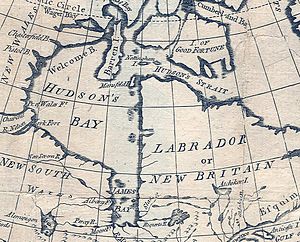
The French and Indian War (1754–1763) was a theater of the Seven Years' War, which pitted the North American colonies of the British Empire against those of the French, each side being supported by various Native American tribes. At the start of the war, the French colonies had a population of roughly 60,000 settlers, compared with 2 million in the British colonies. The outnumbered French particularly depended on their native allies.

Queen Anne's War (1702–1713) was the second in a series of French and Indian Wars fought in North America involving the colonial empires of Great Britain, France, and Spain; it took place during the reign of Anne, Queen of Great Britain. In the United States, it is regarded as a standalone conflict under this name. Elsewhere it is usually viewed as the American theater of the War of the Spanish Succession. It is also known as the Third Indian War. In France it was known as the Second Intercolonial War.

King William's War was the North American theater of the Nine Years' War (1688–1697), also known as the War of the Grand Alliance or the War of the League of Augsburg. It was the first of six colonial wars fought between New France and New England along with their respective Native allies before France ceded its remaining mainland territories in North America east of the Mississippi River in 1763.

Pierre-Esprit Radisson (1636/1640–1710) was a French coureur des bois and explorer in New France. He is often linked to his brother-in-law Médard des Groseilliers. The decision of Radisson and Groseilliers to enter the English service led to the formation of the Hudson's Bay Company. His career was particularly notable for its repeated transitions between serving Britain and France.
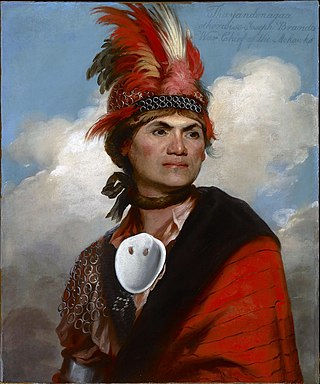
The Mohawk people are the most easterly section of the Haudenosaunee, or Iroquois Confederacy. They are an Iroquoian-speaking Indigenous people of North America, with communities in southeastern Canada and northern New York State, primarily around Lake Ontario and the St. Lawrence River. As one of the five original members of the Iroquois League, the Mohawk are known as the Keepers of the Eastern Door – the traditional guardians of the Iroquois Confederation against invasions from the east.

The Beaver Wars, also known as the Iroquois Wars or the French and Iroquois Wars were a series of conflicts fought intermittently during the 17th century in North America throughout the Saint Lawrence River valley in Canada and the Great Lakes region which pitted the Iroquois against the Hurons, northern Algonquians and their French allies. As a result of this conflict, the Iroquois destroyed several confederacies and tribes through warfare: the Hurons or Wendat, Erie, Neutral, Wenro, Petun, Susquehannock, Mohican and northern Algonquins whom they defeated and dispersed, some fleeing to neighbouring peoples and others assimilated, routed, or killed.

Jacques-René de Brisay, Marquis de Denonville was the Governor General of New France from 1685 to 1689 and was an important figure during the intermittent conflict between New France and the Iroquois known as the Beaver Wars.
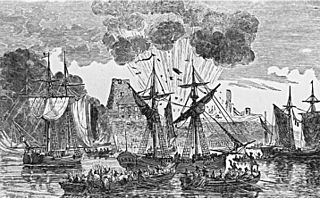
The Battle of Fort Frontenac took place on August 26–28, 1758 during the Seven Years' War between France and Great Britain. The location of the battle was Fort Frontenac, a French fort and trading post which is located at the site of present-day Kingston, Ontario, at the eastern end of Lake Ontario where it drains into the St. Lawrence River.
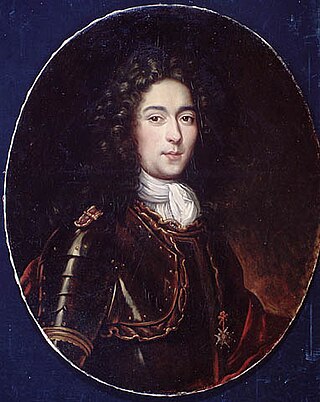
Daniel de Rémy de Courcelle, Sieur de Montigny, de La Fresnaye et de Courcelle was the Governor General of New France from 1665 to 1672.

The Schenectady massacre was an attack against the colonial settlement of Schenectady in the English Province of New York on February 8, 1690. A raiding party of 114 French soldiers and militiamen, accompanied by 96 allied Mohawk and Algonquin warriors, attacked the unguarded community, destroying most of the homes, and killing or capturing most of its inhabitants. Sixty residents were killed, including 11 Black slaves. About 60 residents were spared, including 20 Mohawk.

The Hudson Bay expedition was a series of military raids on the fur trading outposts and fortifications of the British Hudson's Bay Company on the shores of Hudson Bay by a French Royal Navy squadron under the command of the Comte de Lapérouse. Setting sail from Cap-Français, Saint-Domingue in 1782, the expedition was part of a series of globe-spanning naval conflicts between France and Great Britain during the American Revolutionary War.
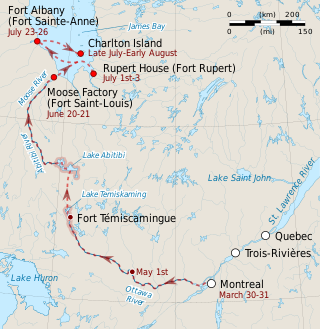
The Hudson Bay expedition of 1686 was one of the Anglo-French conflicts on Hudson Bay. It was the first of several expeditions sent from New France against the trading outposts of the Hudson's Bay Company in the southern reaches of Hudson Bay. Led by the Chevalier de Troyes, the expedition captured the outposts at Moose Factory, Rupert House, Fort Albany, and the company ship Craven.

The 1688 Battle of Fort Albany was one of the Anglo-French conflicts on Hudson Bay. In the Hudson Bay expedition (1686) the French had, in time of peace, marched overland from Quebec and captured all three English posts on James Bay. The French had left a garrison at Fort Albany and needed to send a ship to resupply it and take out the furs. The Hudson's Bay Company learned of its loss in January 1687 and appealed to the king. This led to about a year of diplomatic negotiations. In 1688 the Company sent five ships to the Bay. Two went to its remaining post at York Factory, one went to reestablish Rupert House which the French had burned and two went to Fort Albany on the west shore of James Bay. Their instructions were to re-establish the English trade and not to use force against the French unless the French did so first.
The Battle of Fort Albany in 1693 was the successful recapture by English forces of the Hudson's Bay Company trading outpost at Fort Albany in the southern reaches of Hudson Bay. The fort, captured by a French expedition in 1686 and held by them in a battle the next year, was briefly defended by five Frenchmen, who then abandoned the fort and its stockpile of furs to a four-ship English fleet commanded by James Knight.
Battle of Fort Albany may refer to one of several battles that took place in and around what is now Fort Albany, Ontario. Once an outpost of the Hudson's Bay Company, the fort was the site of conflict before and during King William's War and Queen Anne's War:
The Northeast Coast campaign was the first major campaign by the French of Queen Anne's War in New England. Alexandre Leneuf de La Vallière de Beaubassin led 500 troops made up of French colonial forces and the Wabanaki Confederacy of Acadia. They attacked English settlements on the coast of present-day Maine between Wells and Casco Bay, burning more than 15 leagues of New England country and killing or capturing more than 150 people. The English colonists protected some of their settlements, but a number of others were destroyed and abandoned. Historian Samuel Drake reported that, "Maine had nearly received her death-blow" as a result of the campaign.
Henley House, the first inland post established by the Hudson's Bay Company, was located in what is now Kenora District, Ontario, Canada. It was strategically situated west of James Bay about 160 miles (257 km) up the east-flowing Albany River at the mouth of the Henley River, 8 miles (13 km) downstream of the confluence of the major north-flowing Kenogami River with the Albany. From the head of the Albany at Lake St. Joseph, a portage led west to Lac Seul from which the English River (Ontario) led to the Winnipeg River and westward. The Kenogami led south toward Wawa, Ontario, but that does not seem to have been a practical canoe route all the way to Lake Superior.
Nicolas d'Ailleboust de Manthet, also known as Nicolas de Manthet, born 1664, killed in action 1709, was a Canadian captain in the French marines serving in Canada. He was one of the leaders of the French and Indians at the Schenectady massacre 1690.
